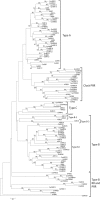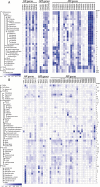Genome-wide analysis of two-component systems and prediction of stress-responsive two-component system members in soybean
- PMID: 20817745
- PMCID: PMC2955714
- DOI: 10.1093/dnares/dsq021
Genome-wide analysis of two-component systems and prediction of stress-responsive two-component system members in soybean
Abstract
In plants, the two-component systems (TCSs) play important roles in regulating diverse biological processes, including responses to environmental stress stimuli. Within the soybean genome, the TCSs consist of at least 21 histidine kinases, 13 authentic and pseudo-phosphotransfers and 18 type-A, 15 type-B, 3 type-C and 11 pseudo-response regulator proteins. Structural and phylogenetic analyses of soybean TCS members with their Arabidopsis and rice counterparts revealed similar architecture of their TCSs. We identified a large number of closely homologous soybean TCS genes, which likely resulted from genome duplication. Additionally, we analysed tissue-specific expression profiles of those TCS genes, whose data are available from public resources. To predict the putative regulatory functions of soybean TCS members, with special emphasis on stress-responsive functions, we performed comparative analyses from all the TCS members of soybean, Arabidopsis and rice and coupled these data with annotations of known abiotic stress-responsive cis-elements in the promoter region of each soybean TCS gene. Our study provides insights into the architecture and a solid foundation for further functional characterization of soybean TCS elements. In addition, we provide a new resource for studying the conservation and divergence among the TCSs within plant species and/or between plants and other organisms.
Figures





Similar articles
-
Genome-wide identification, phylogeny, duplication, and expression analyses of two-component system genes in Chinese cabbage (Brassica rapa ssp. pekinensis).DNA Res. 2014 Aug;21(4):379-96. doi: 10.1093/dnares/dsu004. Epub 2014 Feb 27. DNA Res. 2014. PMID: 24585003 Free PMC article.
-
Whole-genome analysis of Oryza sativa reveals similar architecture of two-component signaling machinery with Arabidopsis.Plant Physiol. 2006 Oct;142(2):380-97. doi: 10.1104/pp.106.086371. Epub 2006 Aug 4. Plant Physiol. 2006. PMID: 16891544 Free PMC article.
-
Genome-wide survey of the soybean GATA transcription factor gene family and expression analysis under low nitrogen stress.PLoS One. 2015 Apr 17;10(4):e0125174. doi: 10.1371/journal.pone.0125174. eCollection 2015. PLoS One. 2015. PMID: 25886477 Free PMC article.
-
Genome-wide identification, evolution, and expression analysis of carbonic anhydrases genes in soybean (Glycine max).Funct Integr Genomics. 2023 Jan 14;23(1):37. doi: 10.1007/s10142-023-00966-9. Funct Integr Genomics. 2023. PMID: 36639600 Review.
-
Evolutionary expansion, functional diversification, and transcript profiling of plant Glutathione Peroxidases.Plant Sci. 2024 Apr;341:111991. doi: 10.1016/j.plantsci.2024.111991. Epub 2024 Jan 22. Plant Sci. 2024. PMID: 38266716 Review.
Cited by
-
Research Progress on the Roles of Cytokinin in Plant Response to Stress.Int J Mol Sci. 2020 Sep 8;21(18):6574. doi: 10.3390/ijms21186574. Int J Mol Sci. 2020. PMID: 32911801 Free PMC article. Review.
-
Ectopic expression of GmHP08 enhances resistance of transgenic Arabidopsis toward drought stress.Plant Cell Rep. 2021 May;40(5):819-834. doi: 10.1007/s00299-021-02677-6. Epub 2021 Mar 16. Plant Cell Rep. 2021. PMID: 33725150
-
Arabidopsis AHP2, AHP3, and AHP5 histidine phosphotransfer proteins function as redundant negative regulators of drought stress response.Proc Natl Acad Sci U S A. 2013 Mar 19;110(12):4840-5. doi: 10.1073/pnas.1302265110. Epub 2013 Mar 4. Proc Natl Acad Sci U S A. 2013. PMID: 23487796 Free PMC article.
-
Genome-wide expression profiling of soybean two-component system genes in soybean root and shoot tissues under dehydration stress.DNA Res. 2011 Feb;18(1):17-29. doi: 10.1093/dnares/dsq032. Epub 2011 Jan 4. DNA Res. 2011. PMID: 21208938 Free PMC article.
-
Transcriptomic analyses of cacao flavonoids produced in photobioreactors.BMC Genomics. 2021 Jul 19;22(1):551. doi: 10.1186/s12864-021-07871-0. BMC Genomics. 2021. PMID: 34281511 Free PMC article.
References
-
- Stock A.M., Robinson V.L., Goudreau P.N. Two-component signal transduction. Annu. Rev. Biochem. 2000;69:183–215. doi:10.1146/annurev.biochem.69.1.183. - DOI - PubMed
-
- Hwang I., Chen H.C., Sheen J. Two-component signal transduction pathways in Arabidopsis. Plant Physiol. 2002;129:500–15. doi:10.1104/pp.005504. - DOI - PMC - PubMed
-
- Mizuno T. Two-component phosphorelay signal transduction systems in plants: from hormone responses to circadian rhythms. Biosci. Biotechnol. Biochem. 2005;69:2263–76. doi:10.1271/bbb.69.2263. - DOI - PubMed
-
- Pareek A., Singh A., Kumar M., Kushwaha H.R., Lynn A.M., Singla-Pareek S.L. Whole-genome analysis of Oryza sativa reveals similar architecture of two-component signaling machinery with Arabidopsis. Plant Physiol. 2006;142:380–97. doi:10.1104/pp.106.086371. - DOI - PMC - PubMed
Publication types
MeSH terms
Substances
LinkOut - more resources
Full Text Sources

